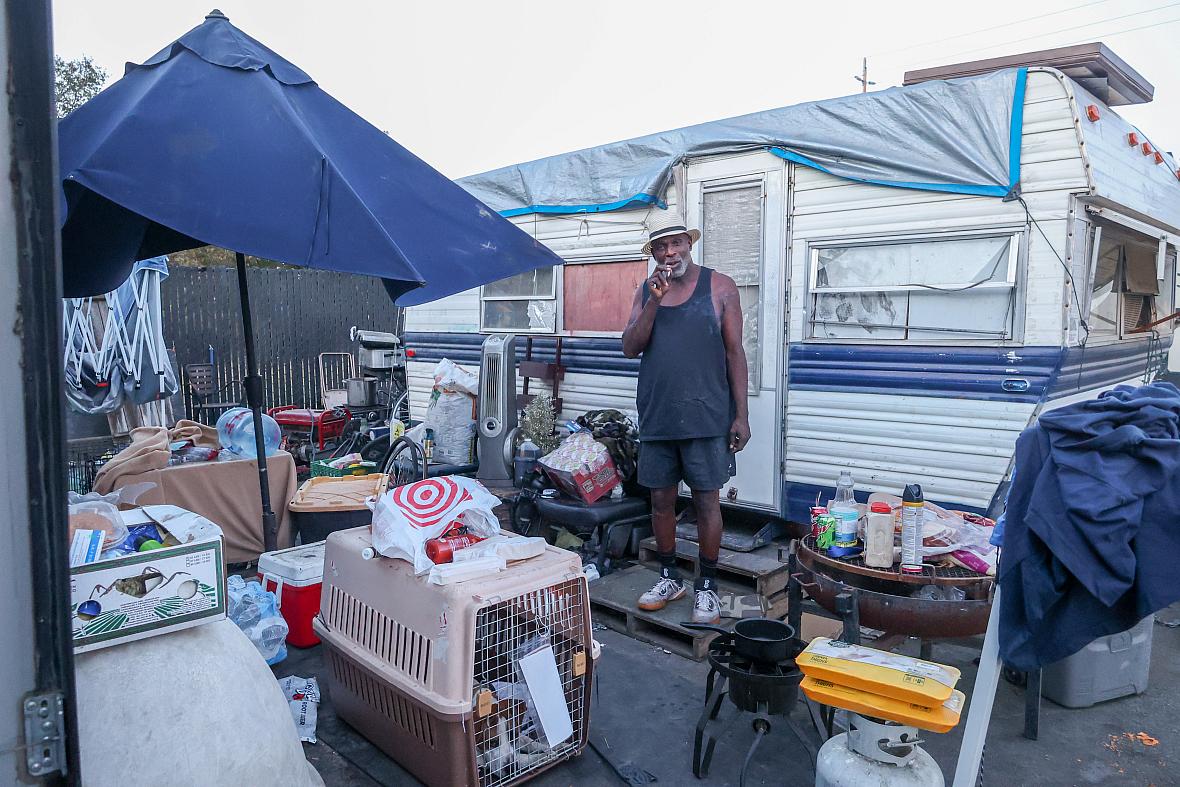SNAP Benefits to Halt on Nov 1 as Shutdown Threatens to Deepen Food Crisis in Sacramento
The story was co-published with Sacramento Observer as part of the 2025 Ethnic Media Collaborative, Healing California.

Dennis McGlothen is one of 267,000 people who may not receive their monthly SNAP benefits beginning Nov. 1 because of the government shutdown. Madeline Church, OBSERVER
Beginning Nov. 1, Sacramento County residents who rely on CalFresh, California’s version of the federal SNAP program, will stop receiving benefits indefinitely as the government shutdown halts funding. This will affect more than 270,000 county residents who depend on the monthly aid to buy food. With no timeline for when the shutdown will end, local officials warn of a growing food crisis that could worsen poverty, strain the local economy, and push more residents toward homelessness.
For Dennis McGlothen, 58, the $298 a month he receives in food assistance is his only income.

Dennis McGlothen was an occupant of Camp Resolution until it was shut down last year and lived on the streets in a tent until July when he was housed by a local program. Madeline Church, OBSERVER
“That’s all I have. That’s all I get because I can’t work,” said McGlothen, a former occupant of Camp Resolution, a homeless encampment, who was housed in July. “I’m very concerned, not just for myself, but what about other people—people that’s older than me and can’t go out to get a hustle? It’s going to be very bad if people don’t get their food stamps.”
Before being housed, McGlothen often cooked for others at the encampment and shared what little food he had. He said food benefits are vital for survival, especially for people with no family or support.
“Food stamps are very vital to people’s survival out here,” McGlothen told The OBSERVER.
The Sacramento County Department of Human Assistance and the Department of Homeless Services and Housing have alerted CalFresh recipients through text messages, social media, and community partners. “Because of the shutdown, at this time CalFresh benefits will not be funded for the month of November,” the county said in a statement. “In Sacramento County, 270,000 people rely on those food benefits to feed themselves and their families. Thousands of children will be affected.”
Ethan Dye, the county’s director of Human Assistance, said the department is working to ensure accurate information reaches residents. “This federal shutdown has created significant uncertainty for families who rely on CalFresh,” he said. “While the County does not control federal funding, our focus is on making sure residents have clear information and know where to turn for local resources.”
In California, 5.5 million people use CalFresh benefits to feed their families, and that includes about 270,000 people in Sacramento county. According to county data, 88,000 CalFresh recipients are under 18, 48,000 are 60 or older, and 241,000 are enrolled in both Medi-Cal and CalFresh.
Early this month, the food assistance program Women Infants and Children, received a limited infusion of tariff funds by the White House to keep the program running during the shutdown, but the measure is temporary and expected to last only a few weeks. State agencies warn they cannot plan beyond that period and are already reducing services. Other child nutrition programs, such as school lunch and breakfast programs, will continue operating in the short term, while summer meal programs remain unaffected. The USDA has issued a contingency plan, but the long-term outlook depends on how long the shutdown continues.
Governor Gavin Newsom announced on Oct. 22 the deployment of the California National Guard and California Volunteers to assist food banks as the federal shutdown delays food benefits for millions of families. He is also fast-tracking up to $80 million in state aid, mirroring the emergency response that helped distribute more than 800 million meals during the pandemic.
“Trump’s failure … it’s literally taking food out of people’s mouths. Millions of Americans rely on food benefits to feed their families, and while Republicans in Washington drag their feet, California is stepping up once again to fill in the gaps,” Newsom said in a statement.
Carlos Marquez III, executive director of the County Welfare Directors Association of California, told KCRA that local administrators are being forced to warn families about an imminent loss of aid. He emphasized three points he wants the public to understand. Recipients will be entitled to back benefits once federal funding resumes, even if November payments are delayed. Any remaining balance on EBT cards from October can still be used throughout November. And people should continue to apply for CalFresh, since eligible families will receive benefits retroactively when the government reopens.
Community advocates say the halt will hit low-income families hardest. The trickle down effect to these cuts could be felt up and down the economy. Grocery stores across California and some restaurants are authorized to accept SNAP benefits. The Center on Budget and Policy Priorities reported that "Increases in SNAP benefits have the largest effects on spending for food and durable goods, and on income and jobs in industries such as manufacturing, trade, and transportation."
Earlier this year, with the reconciliation bill passed by Congress in July, sweeping cuts were already made to the SNAP program. New work rules for able-bodied adults through age 64 and parents with children ages 14 and up were put into place. Additionally, exclusions from work requirements
were eliminated for veterans, people experiencing homelessness, and people ages 18 to 24 who were in foster care when they turned 18. The Congressional Budget Office estimates that these provisions will reduce participation in SNAP by roughly 2.4 million people in an average month over the 2025-2034 period. Marquez said that about 60% of CalFresh recipients are employed. Many who work or go to school will be subjected to onerous paperwork and if they fail to do so, may be limited to receiving SNAP for only three months in a three-year period.
Herman Barahona, co-founder of the Sacramento Environmental Justice Coalition, said many organizations are waiting for state direction and that food banks lack the capacity to meet the coming demand. “The State of California would have to make some announcements on what happens on November 1,” he said. “We’re holding to see if there are any agreements to fund it through state sources or to develop new efforts to supply food for people. We don’t know what’s going to happen with people who cannot buy food in November other than going to the food banks, which we know do not have capacity to serve 267,000 people.”
Barahona said Sacramento’s food insecurity crisis has persisted for years and reflects systemic failures that predate the current shutdown. He described the connection between food assistance and housing as part of a “pipeline to homelessness,” explaining that many unhoused residents once relied on programs like CalFresh or Medi-Cal before losing stability. “These numbers have been high for a while now,” he said. “All of the folks that end up on the streets have, at some point, faced all kinds of conditions that throw them into the streets.”
Crystal Sanchez, president of the Sacramento Homeless Union, said the loss of CalFresh will ripple through the economy. “Grocers lose tons of customers right away. SNAP spending accounts for billions every year at grocery stores, and when that disappears, stores in low-income neighborhoods get hit first and hardest,” she said. “The whole local economy starts to crumble. Cutting SNAP doesn’t just mean empty stomachs—it triggers a public health emergency.”
Sanchez said reduced spending will mean layoffs, smaller paychecks, and cuts to city services. “When SNAP disappears, the pain doesn’t stay at the bottom—it quickly climbs all the way up the ladder,” she said.
Sanchez also pointed out that food insecurity can become a public health and housing crisis. She said families facing hunger make impossible choices—skipping meals, diluting food, or rationing medicine to get by. Children who go to school hungry struggle to learn, while seniors forgo prescriptions to stretch their budgets.
“When people have the basics, everyone benefits—not just SNAP families, but every business and worker connected to the food industry and beyond,” Sanchez said. “Keeping SNAP going is how we keep the whole economy and all our families from falling off a cliff. When we pull SNAP, we pull the rug out from under everyone.”
McGlothen said if SNAP payments stop, he plans to get by with help from family, food banks, and local donors. Many others, he said, won’t have that safety net. “A lot of people that are homeless don’t have family or have lost contact with their family,” he said. “I do have family that I can depend on getting stuff from or from donors and I can go to the food banks.”
He said he still tries to help others when he can, keeping food ready in case someone comes by his home hungry. “My friends come by every day. To take a shower or because they are hungry. I got something in there cooking right now on my stove just in case somebody comes by and they’re hungry. Nobody should ever go hungry.”
This project was supported by the USC Annenberg Center for Health Journalism, and is part of “Healing California”, a yearlong reporting Ethnic Media Collaborative venture with print, online and broadcast outlets across California.

